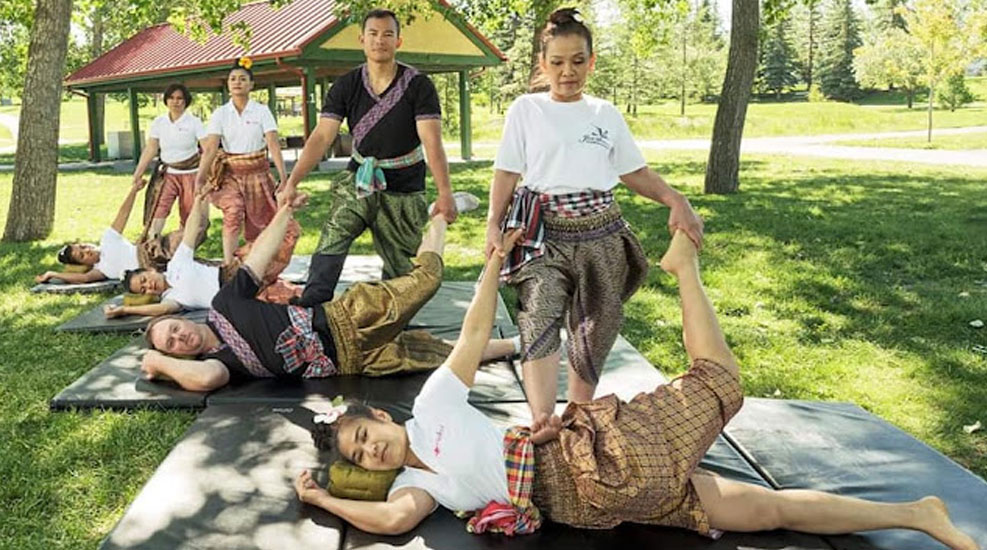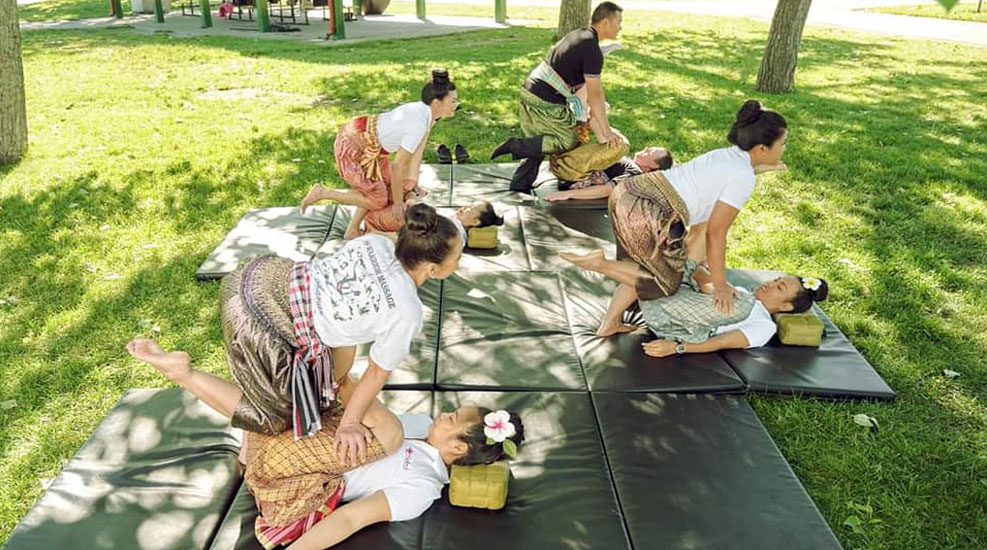Thai Massage Story
The origins of Thai Massage trace back over 2,500 years to Shivago Komarpaj, a herbal doctor from India. Known as the father of Thai Massage, Shivago was instrumental in blending therapeutic practices with spiritual teachings. Thai Massage, rooted in the ancient traditions of Ayurveda, and Buddhist principles, was developed to promote holistic healing.
Unlike Western massage techniques, Thai Massage is a dynamic form of therapy that incorporates acupressure, yoga-style stretches, and gentle rocking movements to stimulate the body’s Sen lines (energy channels) and enhance the flow of vital energy throughout the body. The goal of Thai Massage is to restore balance to the body’s physical, emotional, and spiritual well-being. It involves using the therapist's hands, thumbs, elbows, knees, and feet to apply pressure along these energy lines.
Over centuries, Thai Massage has evolved into a deeply therapeutic practice, celebrated for its ability to alleviate muscle tension, relieve joint pain, boost circulation, improve flexibility, and enhance mental clarity. This practice is based on the belief that the free flow of energy is essential for good health, and blockages within the body’s energy lines can lead to discomfort and illness. Traditionally performed on the floor, Thai Massage combines stretching and pressure techniques that mirror the principles of yoga and typically lasts between 60 to 120 minutes.
Passed down through generations, Thai Massage continues to be practiced by modern-day practitioners in Thailand and around the world, preserving the roots of this ancient healing art. Today, Thai Massage not only serves as a form of physical therapy but also offers a deeply meditative experience that fosters relaxation, mindfulness, and overall well-being, making it a globally cherished practice for those seeking to restore balance and harmony within their bodies and minds.

10 benefits of Thai Massage
1. Increases Range of Motion (ROM) – Active and passive stretching techniques enhance joint mobility and flexibility by reducing muscular tightness and improving synovial fluid circulation in the joints.
2. Alleviates Myofascial Tension – The application of manual pressure and targeted stretching promotes the release of muscle adhesions (trigger points), reducing muscle stiffness and tension.
3. Enhances Peripheral Circulation – Mechanical pressure applied during Thai massage aids in the vasodilation of blood vessels, improving blood flow and oxygen delivery to tissues while facilitating the removal of metabolic waste products.
4. Regulates Energy Flow (Qi) – Thai massage works on the concept of Sen lines, which are believed to regulate the body’s energy (Qi). This therapeutic manipulation aims to restore energy balance and alleviate fatigue.
5. Reduces Sympathetic Nervous System Activation – By stimulating the parasympathetic nervous system, Thai massage reduces sympathetic dominance, which helps lower cortisol levels and mitigates both physiological and psychological stress responses.
6. Improves Postural Alignment – Thai massage techniques targeting the musculoskeletal system promote alignment of the spine and joints, addressing postural deviations, and optimizing body mechanics.
7. Enhances Lymphatic Drainage – Lymphatic stimulation through gentle manipulation encourages lymphatic circulation, helping remove interstitial fluid, metabolic waste, and toxins from the body’s tissues.
8. Alleviates Chronic Pain – The application of pressure, stretching, and mobilization techniques helps to modulate pain receptors, reduce inflammation, and promote natural endorphin release, providing relief from conditions such as myofascial pain syndrome and tension headaches.
9. Improves Joint and Soft Tissue Mobility – Thai massage increases the flexibility of the synovial joints and soft tissues through stretching, reducing joint stiffness and improving articulation and range of motion.
10. Facilitates Cognitive Clarity – The reduction of muscular tension and the restoration of energy flow can help mitigate mental fatigue, enhance focus, and relieve emotional blockages, improving cognitive function and mental clarity.

Learning Objectives for Thai Traditional Massage
By the end of this course, participants will be able to:
1. Understand the Principles of Thai Massage
- Learn the history, philosophy, and cultural significance of Traditional Thai Massage.
- Understand the principles of Sen (energy) lines and their role in holistic healing.
2. Develop Proper Body Mechanics and Practitioner Techniques
- Maintain correct posture and body alignment to prevent strain and enhance longevity in practice.
- Apply effective breathing techniques to synchronize movement and enhance energy flow.
3. Perform Foundational Thai Massage Techniques
- Master key techniques such as palming, thumb pressing, stretching, rocking, and compression.
- Learn how to use hands, elbows, knees, and feet to deliver effective therapeutic techniques.
4. Apply Full-Body Thai Massage Sequences
- Deliver a 60, 90, or 120-minute Traditional Thai Massage session.
- Perform proper sequencing for supine, prone, side-lying, and seated positions.
5. Enhance Client Care and Adapt Techniques
- Assess client needs and adapt techniques for different body types and conditions.
- Modify pressure and stretches based on individual flexibility and comfort levels.
6. Understand Safety, Ethics, and Professionalism
- Identify contraindications and safety precautions for Thai Massage.
- Maintain a professional and ethical approach in practice and client interactions.
7. Integrate Thai Massage into Professional Practice
- Learn how to incorporate Thai Massage into existing massage therapy or wellness practices.
- Develop confidence in providing a holistic, rejuvenating experience for clients.

Precautions and Contraindications of Thai Massage
While Thai massage is generally safe for most individuals, certain conditions require caution or may make the therapy inappropriate. Here are some precautions and contraindications:
Precautions
1. Pregnancy – Thai massage should be avoided, especially during the first trimester, unless under the guidance of a qualified practitioner. Modified techniques may be used during later stages with approval from a healthcare provider.
2. Post-Surgery – Thai massage should be avoided on or near surgical sites until full recovery, as it may interfere with healing or aggravate surgical wounds.
3. Acute Inflammation – Thai massage should not be performed on areas with acute inflammation (e.g., sprains, strains, or active arthritis flare-ups).
4. Fever or Infections – If a client has a fever or any type of active infection, Thai massage should be postponed until they have recovered to avoid spreading illness or worsening the condition.
5. Severe Osteoporosis – Clients with severe osteoporosis should not receive deep pressure or intensive joint manipulation to avoid fractures or injury.
6. Varicose Veins – Clients with varicose veins should avoid direct pressure on the affected areas to prevent damage to the veins.
7. Heart Conditions – Individuals with serious heart conditions (e.g., high blood pressure, heart disease, or arrhythmias) should consult a healthcare provider before receiving Thai massage.
8. Cancer – Thai massage may be contraindicated for clients with active cancer, particularly if the massage targets areas near tumors or delicate tissues. Always consult with a doctor.
9. Acute Herniated Disc – Avoid deep pressure and certain stretches that could exacerbate nerve impingement or worsen symptoms.
10. Uncontrolled Hypertension – Thai massage should be avoided if a client has uncontrolled high blood pressure (hypertension), especially when applying vigorous techniques.
General Contraindications
1. Open Wounds or Skin Infections – Avoid performing Thai massage over areas with open wounds, cuts, or infections.
2. Severe Contusions or Bruising – Do not apply Thai massage to areas with significant bruising or recent trauma to avoid further damage to the tissues.
3. Unstable Medical Conditions – Clients with uncontrolled diabetes, severe asthma, or other unstable medical conditions should avoid Thai massage until their conditions are managed properly.
4. Client Sensitivity - Always tailor the pressure and techniques to the client’s comfort level and communicate regularly during the session. It’s important to adjust the massage according to the client's physical condition and needs. For any medical concerns, always recommend clients to seek medical advice before undergoing Thai massage to ensure it’s suitable for their health issue.